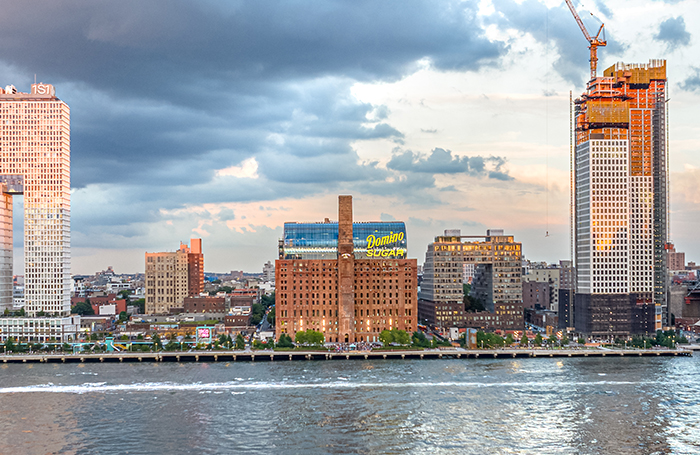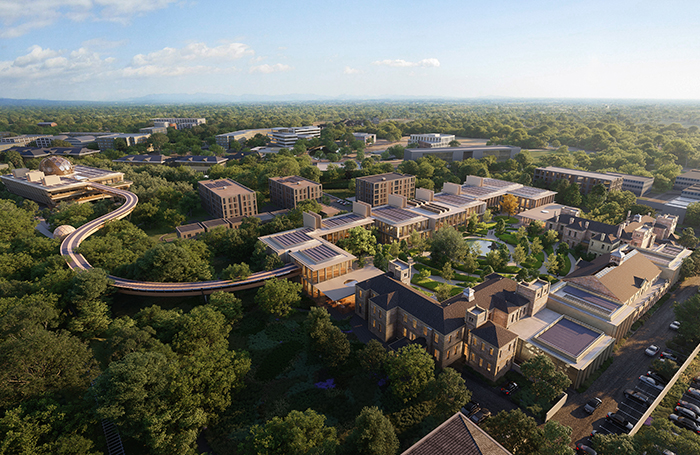In 2024, RIBA launched the Horizons 2034 foresight-gathering initiative, exploring the most significant global trends of the near future – shaping society and the built environment.
The programme was organised around four themes, which broke down into four further topics These resulted in sixteen individual horizon scans, written by separate subject matter experts.
Horizons 2034 revealed several significant interdependencies between themes and topics, calling for a deeper analysis of the parallels, symbioses and tensions between them.
The Future Business of Architecture is the second phase of this research drive. Author Cristian Oncescu, AIA, educator at Yale School of Architecture, and Associate at Newman Architects, scrutinises Horizon 2034’s interdependencies and proposes two evidence-based potential futures – the Ideal Scenario and the Pragmatic Scenario – to speculate on architectural practice in 2035.
The review aims to assist RIBA and global architecture firms in making informed business decisions about their practice composition, clients, markets, and business models.
Today’s geopolitical context
Volatility characterises current geopolitics. The effects of several global crises are working in concert to define the present era as one of “polycrisis”, as defined by Adam Tooze, director of the European Institute at Columbia University. Contributing global events include the COVID-19 pandemic, the war in Ukraine, the energy, cost-of-living, and climate crises, Brexit, China’s real estate crisis and diminishing US ties, and the Trump administration trade policies.
Oncescu’s research posits that global connectedness and globalisation have reached a new peak at the start of 2025, and that, as Tooze predicts, we will be facing a “new cocktail of globalization”, necessitated by the renewable energy transition and the economic development and urbanisation of Africa, among other factors.
Horizon 2034’s global themes
The four major themes of the Horizons 2034 report were (in the order published):
- Environmental Challenge: Carbon reduction, biodiversity loss, and climate adaptation require urgent responses. Sustainability still faces competing pressures, including financial prioritisation and ideological resistance. The profession requires engagement and activism to influence public perception and policy
- The Economics of the Built Environment: Global financial systems increasingly shape urbanisation through remote ownership and speculative development. Architects must understand market forces to develop just and egalitarian built environments in both developed and emerging economies
- Population Change: Ageing populations in the Global North and growing young populations in the Global South drive divergent but equally urgent architectural needs. Housing, healthcare, education, and infrastructure must respond to changing demographics and migration patterns. Architects must respond at the building and urban scale
- Technological Innovation: Artificial intelligence (AI), machine learning, and the industrialisation and automation of construction will transform design processes, professional responsibilities, and building performance. These changes bring both promise and disruption

Cross-cutting tensions between mega-trends
Several conflicting forces emerge:
Sustainability versus everything else
Sustainable architecture and urbanism are undermined by short-term economics favouring new-build over renovation and retrofit. They are imperilled by traditional carbon-intensive construction. They are jeopardised by explosive demographic changes. Moreover, the pace of technological infrastructure construction is outstripping sustainability efforts.
Designing for people versus designing for computers
Advancements in building information modelling (BIM), like digital twins, will have many advantages, including a golden thread of information ideal for safety auditing. Yet digital twins and their integration with modern methods of construction risk building simplification and standardisation, unconnected to context and community. Proliferating AI-augmented automated valuation models (AVMs) and AI agents may give rise to a new, detrimental metric for valuing architecture and urban planning. Future architects will be under pressure to design cities for human-centric use or for AI systems to operate optimally without humans.
Healthy, equitable cities versus financialised urbanism
Goals of wellbeing and equity clash with speculative development and displacement. In the Global North, remote ownership is rampant, diminishing communities and promoting gentrification.
In the Global South, governments are at great risk of being overwhelmed by explosive population growth. Urban sprawl, insufficient infrastructure with attendant implications for public health, and environmental degradation are imminent risks.
Industrialised construction versus sustainable logistics
All across the world, prefabrication, modularity, robotic construction and increased use of BIM face limitations. In the Global South, without upskilling the workforce, material sourcing and building factory capacity, and off-site assembly (within a highly digitised design and construction environment) will not work.
Emerging alignments between mega-trends
Conversely, where trends align, there is potential for optimism and great ideological shifts.
AI and everything else
AI has the potential to reshape the global jobs landscape, affecting population movement and creating new building typologies. Accelerating AI data centre demand could drive investment up to $8 trillion in 2030. AI can also augment the AEC industry specifically by driving deeper insight into building performance during the design phases, improving project delivery and construction, and revolutionising how architecture is valued.
Industrialisation and productisation of construction
If applied responsibly, and utilised for contextual and fit-for-purpose projects, the industrialisation of construction could drive enormous benefits. There is currently a $1.6 trillion productivity gap in the construction industry; the shift to a manufacturing-inspired mass-production system alone could boost productivity tenfold.
Demographic shifts as urbanisation and economic drivers
Demographic trends of longer life expectancy, decreasing birth rates, and ageing populations in the Global North will require suitable buildings. Meanwhile, Africa’s population growth is projected to increase by 400 million people by 2035. The Global South’s young population will be sought to fill skilled labour gaps in the Global North, and the countries that attract them will fare better.
Public policy and financing to mitigate carbon emissions
Energy demand forecast models point to a global net reduction in future GHG emissions, led by reductions in leading economies like China, the US and Europe. Years of sustainability activism in the Global North has yielded new financing and policy frameworks that prioritise renovation and retrofit of existing building stock, like the 2024 EU revised Energy Performance of Buildings Directive (EPBD).
At the same time, important economies of the Global South will continue increasing their GHG emissions in the coming decades. The Global South needs policy activism and financial support to urbanise responsibly, improve resiliency, and build sustainably. Global efforts like the COP29 UN Climate Change Conference in 2024 suggest progress.
Europe already has 80% of building stock needed in 2050. More of the existing housing stock must be renovated or retrofitted. Years of sustainability activism in the Global North has yielded new financing and policy frameworks, like the 2024 EU Revised Energy Performance of Buildings Directive.
Two Possible Futures

To make sense of these tensions and alignments, Oncescu envisions two ‘possible futures’ for the world in 2035.
The Ideal Scenario
In this future, globalisation reaches new highs and the value of global construction work has increased by 40%. Increased investment in renewable energy infrastructure overtakes fossil fuels. Global population growth continues as predicted, in particular in the Global South.
The 2024 EU revised EPBD has been ratified quickly by member countries, resulting in more renovation, less new build, and healthier, more sustainable communities.
Energy-performance-based design approaches, low-carbon energy and material technologies, and increased circularity have proliferated.
Public policies and international investor pressure insist on actionable, measurable sustainability strategies to moderate financialisation. Architects are involved in shaping legislation and education.
The Global South experiences sustainable urbanisation enabled by global partnerships, affordable solar tech, and local upskilling. Increased UN funding for climate vulnerable nations expands. Architects are involved in shaping legislation and education, and collaboration between Global North and South firms contributes to knowledge-sharing and capacity-building. Skilled workforce migration from the Global South plugs the labour gap in the Global North.
Holistic, building performance simulation AI tools are embedded in the design process, having been trained on large amounts of high-quality data from established data trust(s). Architecture has shifted from delivering construction drawings to an outcome-based model. Global construction industry adopts new technologies and practices to increase workforce productivity by 1% annually over the preceding decade.
The Pragmatic Scenario
In this future, globalisation, construction work, investment in renewable energy infrastructure, and global population growth increase similar to the Ideal Scenario
Significantly less adaptive reuse and renovation takes place due to slow ratification of the 2024 EU revised EPBD and inconsistent new policies. New European financial support for low-carbon energy and material technologies falters, and high-carbon materials remain standard. Financialised real estate dominates unchecked.
AI tools are deployed for discrete tasks, but their full potential is unrealised. Industry wide data sharing has not come to pass.
The Global South experiences rapid urban growth but suffers through lack of climate resilience, underinvestment in skills, lack of collaborative support; inequalities are amplified.
Infrastructure spending by UN and Global South governments is insufficient. The labour force in the Global South largely avoids migration to Global North, leaving labour gaps unfilled.
AI tools are deployed for discrete, automatable tasks, but their full potential is unrealised. Industry-wide data sharing has not come to pass. Productivity growth is subdued for the global construction industry, and construction supply in the developed world falls short of high demand by trillions of dollars.
Implications for industry (across both scenarios)
Market implications
Construction activity will increase to 2035 due to predicted population growth, but success looks different geographically. Key differences include:
| Global North | Global South |
| Declining birthrate and ageing population = construction labour shortage. | Rapid population growth = continuous supply of labour. |
| Demand for healthcare infrastructure, lifetime homes, multigenerational homes, alternate housing models such as co-ops. | Need for new infrastructure, healthcare, schools, homes, urban planning. Sub-Saharan Africa and emerging Asia will be fastest growing global regions. By 2037 India will see more construction growth than the US. |
| Construction characterised by greater renovation, retrofit, and reuse. Many commercial and residential real estate clients are already responding to investor pressure to create ESG-driven projects. | Demand for sustainable and equitable new build. An estimated 80% of buildings needed for Africa’s population by 2050 have not been built yet. |
| Data centre demand booms. By 2035, these take up 4.5% of global power demand. | Likely to house the data centres required to service the Global North. |
| Opportunities arise for educational and professional knowledge-sharing. | Collaboration opportunities in support of an equitable and sustainable future. |
Firm implications by size
Small firms will continue to play a key role in community and renovation projects but struggle with adopting new technology. In the UK, their share of professional fees has stayed steady over the last decade, unlike in the US where it dropped sharply.
Midsize firms will continue to benefit from multi-disciplinary teams and diversified project types. Tech adoption is easier than for smaller firms. Those that develop a unique selling point or collaborate with others will be more viable. In the UK, their share of fees has also remained largely unchanged, unlike in the US.
Large firms will continue to dominate international markets. Their global reach gives them a head start in emerging markets in the Global South, making them the first choice for governments and major developers, until local firms expand. Large UK firms (100+ staff) now bring in over 80% of all overseas income, doubling in the past two years.

Education and professional skills
Architectural education must evolve to embed climate literacy, community engagement, and data fluency.
Professional organisations must target continuing professional development (CPD).
Architectural firms in 2035 will not hire individuals in specific sustainability positions, as most employees will need to be knowledgeable. Firms must allocate funds for the relevant training and qualifications.
AI impact and integration
AI will reshape architecture roles.
In terms of the RIBA Plan of Work, AI is likely to have the most impact on stages 4-5 (e.g. repeatable tasks, technical drawings, code compliance). Stages 0-3 (strategic, creative, subjective) and the work of securing relationships for repeat business are not automatable, requiring human touch and team chemistry.
If the Ideal Scenario comes to pass, architects will have the luxury of holistic AEC AI software suites that provide simulated performance, cost, and schedule data.
The challenge of developing useful AEC AI models comes down to the availability of well-curated data for training AI models.
The collection of such data requires the establishment of a data trust – an independent third party who collects, manages, anonymizes, and provides access to a large-scale collection of cross-disciplinary data.
The problem of delegating professional responsibility and legal accountability to machine algorithms arises when boundaries between computation and human work are blurred.
The risk is softened however, due to software companies historically structuring their end user license agreements (EULAs) to avoid legal responsibility for the use and misuse of their products. In both future scenarios, automated AI software will necessitate a human user in the driver’s seat.
Business models
The traditional fee models (based on drawing deliverables or hours) may give way to performance-based contracts, redefining how architectural value is measured and rewarded. Contract frameworks like integrated project delivery (IPD) can be a model for shifting away from commoditised deliverables to fees commensurate with the value added to clients and society.
Conclusion
Whether architecture and the world’s built environment resembles more the Ideal or the Pragmatic scenario in the year 2035 depends on the decisions made today – by individuals, firms, and policymakers. Practices will succeed by being adaptable; embracing and understanding new technologies is paramount, as is fostering the future generation of practitioners and seeking out collaborative knowledge-sharing with other professionals. Advocacy and activism are equally important, to engage the cooperation of governments, clients and investors. The tensions between climate, population change, finance and technology are substantial but not insurmountable, as long as the profession makes a concerted effort to nurture the areas in which these mega-trends align.
The Impact of Global Trends on Tomorrow's Practice: The Horizons 2034/Future Business of Architecture Review is by Cristian Oncescu; the executive summary by Michèle Woodger.









